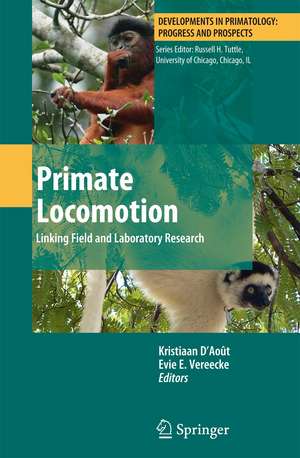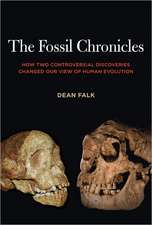Primate Locomotion: Linking Field and Laboratory Research: Developments in Primatology: Progress and Prospects
Editat de Kristiaan D'Août, Evie E. Vereeckeen Limba Engleză Paperback – 28 ian 2013
We are convinced that the most appropriate format to publish the different symposium contributions is a conference volume within an existing book series. Firstly, the chapters will not only contain new data but will also review existing data and elaborate on potential future work – more so than can bedone in a journal article.
Secondly, the combination of chapters will form an entity that is more valuable than the sum of the separate chapters and therefore they need to be presented together. Lastly, this volume will benefit from the typically long "shelf life" of a book in a renowned series, allowing it to be used as reference book for both researchers and students.
| Toate formatele și edițiile | Preț | Express |
|---|---|---|
| Paperback (1) | 948.92 lei 43-57 zile | |
| Springer – 28 ian 2013 | 948.92 lei 43-57 zile | |
| Hardback (1) | 952.89 lei 43-57 zile | |
| Springer – 6 dec 2010 | 952.89 lei 43-57 zile |
Din seria Developments in Primatology: Progress and Prospects
- 20%
 Preț: 571.31 lei
Preț: 571.31 lei - 18%
 Preț: 1216.65 lei
Preț: 1216.65 lei - 19%
 Preț: 578.66 lei
Preț: 578.66 lei - 18%
 Preț: 956.69 lei
Preț: 956.69 lei - 18%
 Preț: 948.92 lei
Preț: 948.92 lei - 18%
 Preț: 945.79 lei
Preț: 945.79 lei - 18%
 Preț: 962.66 lei
Preț: 962.66 lei - 18%
 Preț: 1664.43 lei
Preț: 1664.43 lei - 18%
 Preț: 1224.54 lei
Preț: 1224.54 lei - 24%
 Preț: 826.25 lei
Preț: 826.25 lei - 24%
 Preț: 802.74 lei
Preț: 802.74 lei - 18%
 Preț: 1562.94 lei
Preț: 1562.94 lei - 18%
 Preț: 950.21 lei
Preț: 950.21 lei - 18%
 Preț: 943.73 lei
Preț: 943.73 lei - 18%
 Preț: 1549.67 lei
Preț: 1549.67 lei - 18%
 Preț: 1248.20 lei
Preț: 1248.20 lei - 18%
 Preț: 941.38 lei
Preț: 941.38 lei - 24%
 Preț: 800.85 lei
Preț: 800.85 lei - 18%
 Preț: 953.35 lei
Preț: 953.35 lei - 18%
 Preț: 1827.48 lei
Preț: 1827.48 lei - 18%
 Preț: 1214.90 lei
Preț: 1214.90 lei - 18%
 Preț: 957.62 lei
Preț: 957.62 lei - 18%
 Preț: 1231.47 lei
Preț: 1231.47 lei - 18%
 Preț: 1225.48 lei
Preț: 1225.48 lei - 5%
 Preț: 1433.83 lei
Preț: 1433.83 lei - 18%
 Preț: 1231.16 lei
Preț: 1231.16 lei - 18%
 Preț: 1226.90 lei
Preț: 1226.90 lei - 18%
 Preț: 955.25 lei
Preț: 955.25 lei - 18%
 Preț: 956.03 lei
Preț: 956.03 lei - 18%
 Preț: 1218.53 lei
Preț: 1218.53 lei - 18%
 Preț: 950.52 lei
Preț: 950.52 lei -
 Preț: 416.82 lei
Preț: 416.82 lei - 18%
 Preț: 1554.89 lei
Preț: 1554.89 lei
Preț: 948.92 lei
Preț vechi: 1157.22 lei
-18% Nou
Puncte Express: 1423
Preț estimativ în valută:
181.58€ • 190.06$ • 151.13£
181.58€ • 190.06$ • 151.13£
Carte tipărită la comandă
Livrare economică 31 martie-14 aprilie
Preluare comenzi: 021 569.72.76
Specificații
ISBN-13: 9781461427773
ISBN-10: 1461427770
Pagini: 380
Ilustrații: XVI, 364 p.
Dimensiuni: 155 x 235 x 20 mm
Greutate: 0.54 kg
Ediția:2011
Editura: Springer
Colecția Springer
Seria Developments in Primatology: Progress and Prospects
Locul publicării:New York, NY, United States
ISBN-10: 1461427770
Pagini: 380
Ilustrații: XVI, 364 p.
Dimensiuni: 155 x 235 x 20 mm
Greutate: 0.54 kg
Ediția:2011
Editura: Springer
Colecția Springer
Seria Developments in Primatology: Progress and Prospects
Locul publicării:New York, NY, United States
Public țintă
ResearchCuprins
Foreword
Tuttle RH
Chapter 1: Introduction: Primate locomotion – towards a synergy of laboratory and field research.
Vereecke AA & D’Août K
Chapter 2: Translating primate locomotor biomechanical variables from the laboratory to the field.
Schmitt D
Chapter 3: Studying captive ape locomotion: past, present and future.
Vereecke EE, D’Août K & Aerts P
Chapter 4: Experimental and computational studies of bipedal locomotion in the bipedally-trained Japanese macaque.
Ogihara N, Hirasaki E & Nakatsukasa M
Chapter 5: In what manner do quadrupedal primates walk on two legs? Preliminary results on Olive Baboons (Papio anubis).
Berillon G, D’Août K, Daver G, Dubreuil G, Multon F, Nicolas G & de la Villetanet B
Chapter 6: Scapula movements and their contribution to three-dimensional forelimb excursions in quadruped primates.
Schmidt M & Krause C
Chapter 7: The influence of load carrying on gait parameters in humans and apes: implications for the evolution of human bipedalism.
Watson J, Payne R, Chamberlain A, Jones R & Sellers W
Chapter 8: Field and experimental approaches to the study of locomotor ontogeny in Propithecus verreauxi.
Wunderlich RE, Lawler RR & Williams AE
Chapter 9: Comparisons of limb structural properties in free-ranging chimpanzees from Kibale, Gombe, Mahale, and Taï communities.
Carlson KJ, Wrangham RW, Muller MN, Sumner DR, Morbeck ME, Nishida T, Yamanaka A & Boesch C
Chapter 10: Field study methods for primate locomotion.
Blanchard M, Sellers WI & Crompton RH
Chapter 11: Gibbon locomotion research in the field – problems, possibilities and benefits for conservation.
Cheyne SM
Chapter 12: Posture, ischial tuberosities and tree zone use is West African cercopithecids
McGraw & Sciulli PW.
Chapter 13: Forelimb suspensory gait characteristics of wild Lagothrix poeppigii and Ateles belzebuth: developing video based methodologies in free-ranging primates.
Guillot DM
Chapter 14: Gait and kinematics of arboreal quadrupedal walk of free-ranging red howlers (Alouatta seniculus) in French Guiana.
Youlatos D & Gasc J-P
Chapter 15: Fromtreadmill to tropics: calculating ranging cost in chimpanzees.
Pontzer H, Raichlen DA & Sockol MD
Chapter 16: Linking field and laboratory approaches for studying primate locomotor responses to support orientation.
Stevens NJ, Ratsimbazafy JH & Ralainasolo F
Chapter 17: Quadrupedal locomotion of Saimiri boliviensis: a comparison of field and lab-based kinematic data.
Shapiro LJ, Young JW & Souther A
Tuttle RH
Chapter 1: Introduction: Primate locomotion – towards a synergy of laboratory and field research.
Vereecke AA & D’Août K
Chapter 2: Translating primate locomotor biomechanical variables from the laboratory to the field.
Schmitt D
Chapter 3: Studying captive ape locomotion: past, present and future.
Vereecke EE, D’Août K & Aerts P
Chapter 4: Experimental and computational studies of bipedal locomotion in the bipedally-trained Japanese macaque.
Ogihara N, Hirasaki E & Nakatsukasa M
Chapter 5: In what manner do quadrupedal primates walk on two legs? Preliminary results on Olive Baboons (Papio anubis).
Berillon G, D’Août K, Daver G, Dubreuil G, Multon F, Nicolas G & de la Villetanet B
Chapter 6: Scapula movements and their contribution to three-dimensional forelimb excursions in quadruped primates.
Schmidt M & Krause C
Chapter 7: The influence of load carrying on gait parameters in humans and apes: implications for the evolution of human bipedalism.
Watson J, Payne R, Chamberlain A, Jones R & Sellers W
Chapter 8: Field and experimental approaches to the study of locomotor ontogeny in Propithecus verreauxi.
Wunderlich RE, Lawler RR & Williams AE
Chapter 9: Comparisons of limb structural properties in free-ranging chimpanzees from Kibale, Gombe, Mahale, and Taï communities.
Carlson KJ, Wrangham RW, Muller MN, Sumner DR, Morbeck ME, Nishida T, Yamanaka A & Boesch C
Chapter 10: Field study methods for primate locomotion.
Blanchard M, Sellers WI & Crompton RH
Chapter 11: Gibbon locomotion research in the field – problems, possibilities and benefits for conservation.
Cheyne SM
Chapter 12: Posture, ischial tuberosities and tree zone use is West African cercopithecids
McGraw & Sciulli PW.
Chapter 13: Forelimb suspensory gait characteristics of wild Lagothrix poeppigii and Ateles belzebuth: developing video based methodologies in free-ranging primates.
Guillot DM
Chapter 14: Gait and kinematics of arboreal quadrupedal walk of free-ranging red howlers (Alouatta seniculus) in French Guiana.
Youlatos D & Gasc J-P
Chapter 15: Fromtreadmill to tropics: calculating ranging cost in chimpanzees.
Pontzer H, Raichlen DA & Sockol MD
Chapter 16: Linking field and laboratory approaches for studying primate locomotor responses to support orientation.
Stevens NJ, Ratsimbazafy JH & Ralainasolo F
Chapter 17: Quadrupedal locomotion of Saimiri boliviensis: a comparison of field and lab-based kinematic data.
Shapiro LJ, Young JW & Souther A
Recenzii
From the reviews:
“As the subtitle indicates, the contributions in this book aim to synthesize field and laboratory studies. The editors have compiled 17 chapters … by 45 contributors that cover a wide variety of topics related to locomotor behavior. … Figure quality, including some color illustrations, throughout the book is quite good … . Summing Up: Recommended. Upper-division undergraduates through professionals in primatology, biological anthropology, and zoology.” (E. J. Sargis, Choice, Vol. 48 (10), June, 2011)
“This new volume amply illustrates both the complex nature of research into primate locomotion and the ways such scholarship is developing today. … provides a clear, wide-ranging summary of current research into primate locomotion. For readers interested in the subject or with an interest in the future of primatology, it is an excellent resource. … There are extensive bibliographies … which provide routes into the literature, and the variety of example species and settings used means there may well be ‘something for everyone’.” (Isabelle Winder, Primate Eye, February, 2012)
“This new volume contains 16 research and review articles on nonhuman primate locomotion. … This collection of papers demonstrates that both laboratory and field research complement each other, and that both are relevant to comprehensively understand primate locomotor biology and its evolution. Future research in this and similar fields will benefit from the continued interdisciplinary approaches demonstrated in this edited volume.” (Biren A. Patel, The Quarterly Review of Biology, Vol. 87 (2), June, 2012)
“As the subtitle indicates, the contributions in this book aim to synthesize field and laboratory studies. The editors have compiled 17 chapters … by 45 contributors that cover a wide variety of topics related to locomotor behavior. … Figure quality, including some color illustrations, throughout the book is quite good … . Summing Up: Recommended. Upper-division undergraduates through professionals in primatology, biological anthropology, and zoology.” (E. J. Sargis, Choice, Vol. 48 (10), June, 2011)
“This new volume amply illustrates both the complex nature of research into primate locomotion and the ways such scholarship is developing today. … provides a clear, wide-ranging summary of current research into primate locomotion. For readers interested in the subject or with an interest in the future of primatology, it is an excellent resource. … There are extensive bibliographies … which provide routes into the literature, and the variety of example species and settings used means there may well be ‘something for everyone’.” (Isabelle Winder, Primate Eye, February, 2012)
“This new volume contains 16 research and review articles on nonhuman primate locomotion. … This collection of papers demonstrates that both laboratory and field research complement each other, and that both are relevant to comprehensively understand primate locomotor biology and its evolution. Future research in this and similar fields will benefit from the continued interdisciplinary approaches demonstrated in this edited volume.” (Biren A. Patel, The Quarterly Review of Biology, Vol. 87 (2), June, 2012)
Textul de pe ultima copertă
Primate locomotion has typically been studied from two points of view. Laboratory-based researchers have focused on aspects like biomechanics and energetics, whereas field-based researchers have focused on (locomotor) behaviour and ecology. Primate Locomotion: Linking Field and Laboratory Research brings together both aspects of primate locomotion studies. Communication between both groups is necessary to identify the specific needs and start up achievable and successful research projects in the field. This volume brings together biomechanists, ecologists, and field-based researchers, who combine both disciplines, and whose contributions facilitate lasting cooperation between the mentioned disciplines and stimulate innovative research in Primatology. The book will be valuable for primatologists, paleo-anthropologists, biomechanists and field biologists, as well as students. About the Editors: Dr. Kristiaan D’Aout is Assistant Professor in the Department of Biology, University of Antwerp, Belgium. Dr. D’Aout is also Research Associate for the Locomorph Project and Coordinator of Biodynamics Research at the Centre for Research and Conservation at the Royal Zoological Society of Antwerp, Belguim. Evie E. Vereecke is part of the Primate Evolution and Morphology Group, School for Biomedical Sciences, University of Liverpool, UK; and Laboratory for Functional Morphology, Department of Biology, University of Antwerp, Belgium.
Caracteristici
The book will be valuable for researchers as well as teachers and students, in particular those involved in university courses such as Primatology and Biological Anthropology. The result of a symposium on the 2008 Meeting of the International Primatological Society in Edinburgh, Scotland.








